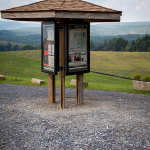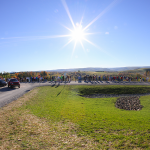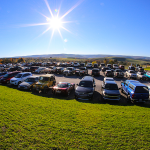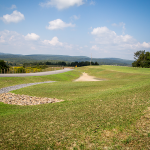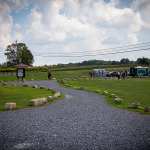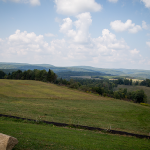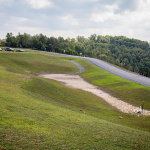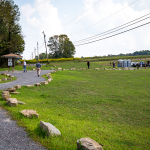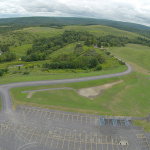I recently had the pleasure of participating in the Winslow Hill Elk Viewing Improvements dedication. As a speaker at the dedication, I had the opportunity to reflect on the design challenges we faced in order to meet the needs of this important viewing area.
Design Challenges
Let’s start at the beginning, since many don’t realize that elk roam these parts of Penn’s Woods. The last native Pennsylvania elk was killed in the late 1800s. From 1913 until 1923, the Pennsylvania Game Commission (PGC) attempted to restore elk numbers by bringing elk from Yellowstone National Park to Pennsylvania. In total, 177 elk were released into the central and northeastern parts of Pennsylvania, but only the northcentral population survived. The elk currently roaming the mountains of northcentral Pennsylvania are the descendants of the animals that remained. Today, Pennsylvania is home to 900-1,000 elk—the largest herd in the northeastern United States. The elk found on Winslow Hill, located in Benezette, Elk County, make up the largest subpopulation of elk in Pennsylvania. In 2010, the Pennsylvania Department of Environmental Protection (PA-DEP) Bureau of Abandoned Mine Reclamation (BAMR) completed the final surface mine reclamation project associated with the restoration efforts in the Dents Run Watershed. This transformed a once forested hillside into open grasslands, which quickly attracted elk. This open hillside was visible from the intersection of Winslow Hill and Dewey Roads. It became a popular place for folks to view elk in their natural setting. Although it was never meant to be a viewing area, it quickly became one. Also in 2010, Pennsylvania’s Department of Conservation and Natural Resources (DCNR) opened the Elk Country Visitor’s Center. This world-class destination soon became the hub of activity, and by 2014, the number of visitors to Winslow Hill increased to over 400,000.
As a landscape architect, I spend a lot of time solving problems created by conflicts between vehicles and pedestrians. The Winslow Hill Elk Viewing project adds a third dimension to the typical pedestrian/vehicle conflict—the large elk herds. The PGC knew they had a problem, as the amount of visitors continued to rise year after year. The existing local roads exhibit poor roadway geometry and sight distance, and visitors parking along the shoulders created deep rutted mud. These pseudo-parking areas also created gridlock because of the narrowed travel lanes caused by helter-skelter parking, existing narrow paved width of the roadways, and constant backing in and out of the makeshift parking areas.
Pedestrians didn’t help the situation either; no defined walkways existed and people walk toward the elk herds regardless of the herd’s location, creating lots of foot traffic along the roadways and in between cars. These pedestrian movements were dangerous and produced many close calls over the years.
Lastly, the elk herds were able to roam wherever they wanted. The PGC could guide the elk in small ways by locating food plots of clover and alfalfa in safe areas, but proper management of the herd requires that fencing and other barriers be used sparingly in the landscape.
Throughout the design process, many options were considered, including the construction of multiple small parking lots along the existing township roads, a large, expanded parking lot at Winslow Road, and multiple pathways to the various viewing spots. Many of these options still created conflict points, although the suggestions reduced the number and severity of the conflicts. Nonetheless, the proposed solutions left anxiety among the design team and review committee, and I still felt that we weren’t fully solving the problem. We continued our sketch planning and finally came to a solution that solved many of the concerns originally identified. The solution was large and complex; it included the relocation of Dewey Road to the perimeter of the project area, expansion of the parking into a large lot with access off the relocated Dewey Road, improvements to Winslow Hill Road to remove a blind spot, new walkways to high points that provide multiple vantage points of the feed plots, locations for educational kiosks, restrooms, and expansion areas if visitation numbers continue to increase. Of course, this solution required more stakeholders to become involved, including the Township Board since the roadways are municipally owned, and the County Conservation District since improvements would disturb many acres. The Design Committee knew the project was complicated, but also knew it was well worth the effort since all conflict points and safety issues were eliminated altogether.
Looking back on the nearly 20 years and hundreds of projects I have been involved with during my design career, this project was quite challenging and very special to me. It ranks in the top ten projects that I have been responsible for. The passion of my client, the Pennsylvania Game Commission, is very rarely seen and was a true pleasure to be a part of. The ability to eliminate safety issues and conflict points seemed like an impossible task during the early design process. I’m pleased with the results of this phase of the project and look forward to the continued success of the management of the elk herd and the ability to allow the public to witness and be so close to these marvelous animals.
 Back
Back


